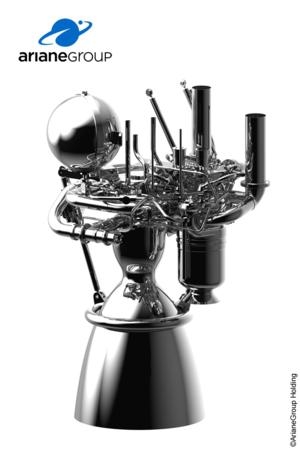Mon, Dec 25, 2017
Precursor For Future European Launch Engines
Prometheus is a European demonstrator for a very low cost reusable engine, running on liquid oxygen (LOx) and methane. It is the precursor for future European launcher engines as of 2030.

The aim is to be able to build future liquid propellant engines with a unit cost of about 1 million euros, or 10 times less than the cost of producing existing engines such as the Vulcain 2. The success of this type of technological challenge demands an entirely new approach and the use of innovative design and production methods and tools. Apart from switching from the traditional Ariane propellant (transition from the liquid oxygen and liquid hydrogen combination to a combination of liquid oxygen and methane), the demonstrator will entail major developments, including digitalization of engine control and diagnostics, and manufacturing using 3D printing in a connected factory environment.
The $88 million contract signed by Daniel Neuenschwander, Director of Space Transportation at the European Space Agency (ESA), and Alain Charmeau, CEO of ArianeGroup, the 50/50 joint-venture set up by the Airbus and Safran groups, covers the design, manufacturing and testing of the first two examples of the Prometheus demonstrator. The French space agency (CNES) is leading in the early design process, and testing is scheduled on the P5 test bed of the German Aerospace Centre (DLR) in Lampoldshausen, Germany, as of 2020.
"The development of Ariane 6 is on track, with a first flight scheduled for 2020. This new Prometheus contract with the European Space Agency is paving the way for the future of European launchers, with the goal of designing and building a reusable engine for one tenth the cost of today's Vulcain 2 type engines. I therefore thank ESA and the Member States for their contribution and their confidence in entrusting us with the development of the European technology of tomorrow."
Following the initial phase which was completed in early December, the first Program Review confirmed the consistency of the design choices with engine specifications and in particular with the recurring cost targets. At the same time, subsystems testing has started with the gas generator campaign (one of the parts built using 3D printing) on the DLR's P8 test bed in Lampoldshausen.
(Image provided with ArianeGroup news release)
More News
Also: Pratt & Whitney 747SP, Gratia Aero, Robinson/MagniX, Jack Pelton Part5 The Avidyne Vantage 12 is finally certified and will shortly be shipping out so that aging Cirrus a>[...]
Aero Linx: Army Aviation Medicine Association (AAVMA) The Society of US Army Flight Surgeons (SoUSAFS) serves to advance the science and art of Aerospace Medicine and its allied sc>[...]
Witnesses Reported That They Heard A Loss Of Engine Power Analysis: Witnesses reported that the airplane departed from runway 35 after a successful runup. During the initial climb,>[...]
Radio Magnetic Indicator An aircraft navigational instrument coupled with a gyro compass or similar compass that indicates the direction of a selected NAVAID and indicates bearing >[...]
"After exiting, I had a vague recollection of what just happened…and a much clearer view of how quickly hypoxia can sneak up. Sign-ups for PROTE are open each day of AirVent>[...]
 OSH25 Day 5 Redux: Avidyne Vantage 12, Is Fly-Inn An AeroBnB?, B25 Miss Mitchell
OSH25 Day 5 Redux: Avidyne Vantage 12, Is Fly-Inn An AeroBnB?, B25 Miss Mitchell ANN's Daily Aero-Linx (07.29.25)
ANN's Daily Aero-Linx (07.29.25) NTSB Final Report: Curtiss Wright P-40E
NTSB Final Report: Curtiss Wright P-40E ANN's Daily Aero-Term (07.29.25): Radio Magnetic Indicator
ANN's Daily Aero-Term (07.29.25): Radio Magnetic Indicator Aero-News: Quote of the Day (07.29.25)
Aero-News: Quote of the Day (07.29.25)



